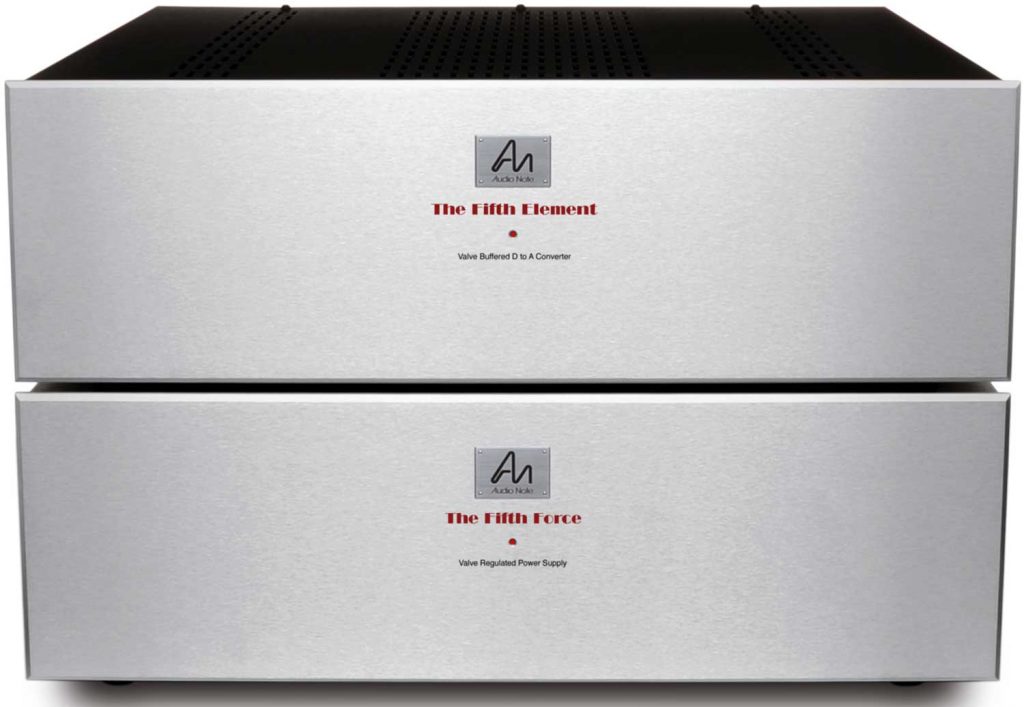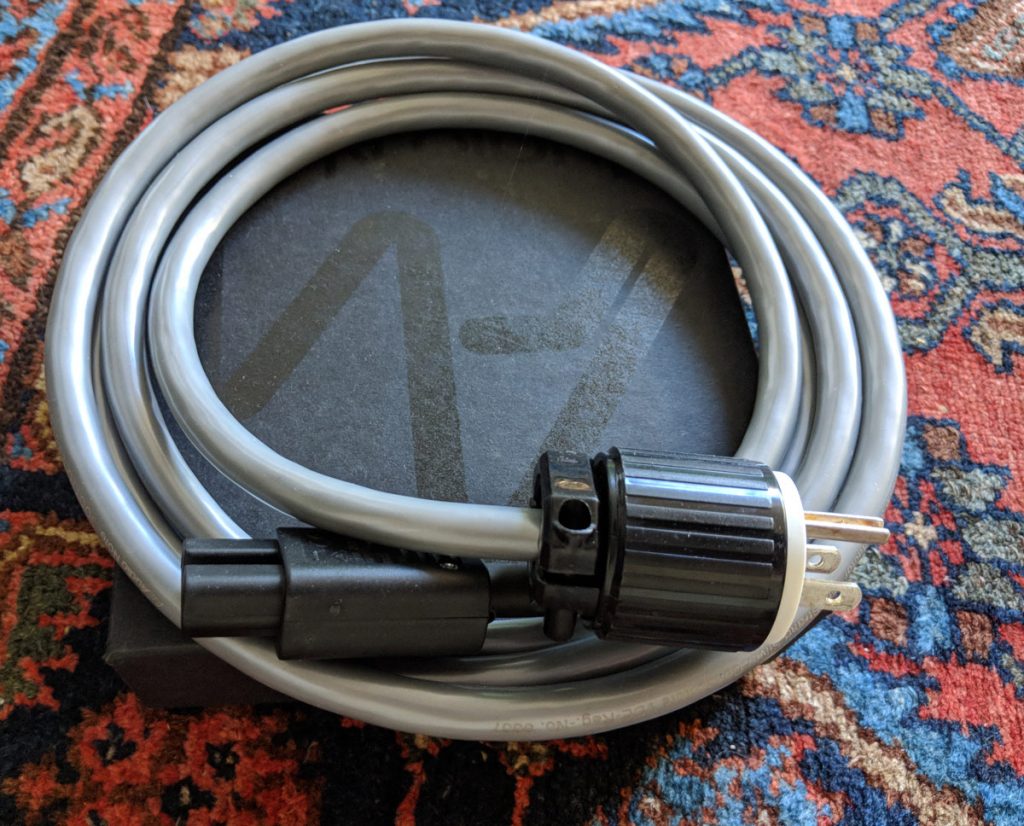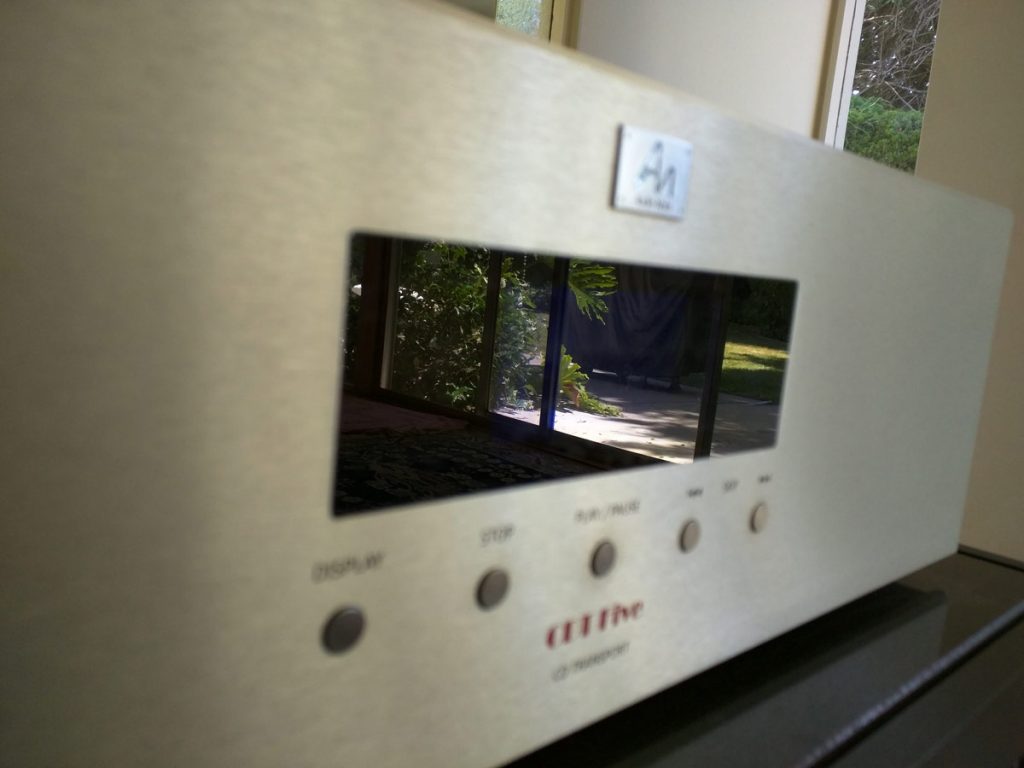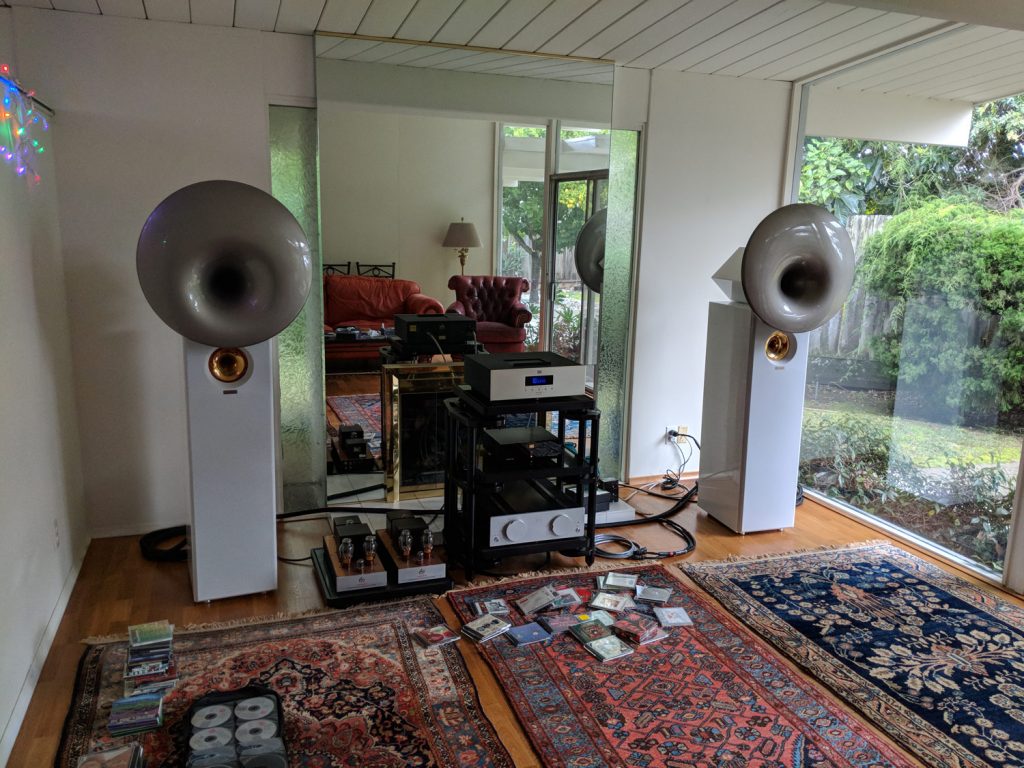In search of streaming music configurations that don’t suck. Or…. Mike and Neli visit the 21st Century.
J. visited us for a few days and we played a lot of music. He is an extremely fun and generous person and we spent the weekend together comparing streaming to CD playback, and even spun a little vinyl.
The goal was to try and make streaming-quality sound be as close as possible to CD-quality sound, using vinyl as a ‘gold standard’ sanity-check to make sure that we were not veering off into some kind of analytical-sounding wasteland.
TL;DR
The sound of streaming audio ranges from sounding really confused and ‘stepped all over’ in its unoptimized default state to, in the best case during our shootout, having very high resolution and being slightly compressed. It really caters more to the Mind and its primary struggle is to communicate to the Heart [this is something the Lampizator naturally struggles with, being more neutral even than the solid-state Emm Labs XDS1 for example, but I am talking here in addition to that. We all listened long enough, and with enough focus, that I think we were able to largely ignore the slight coolness of the Lampizator to the literally dozens of changes in sound that we made].
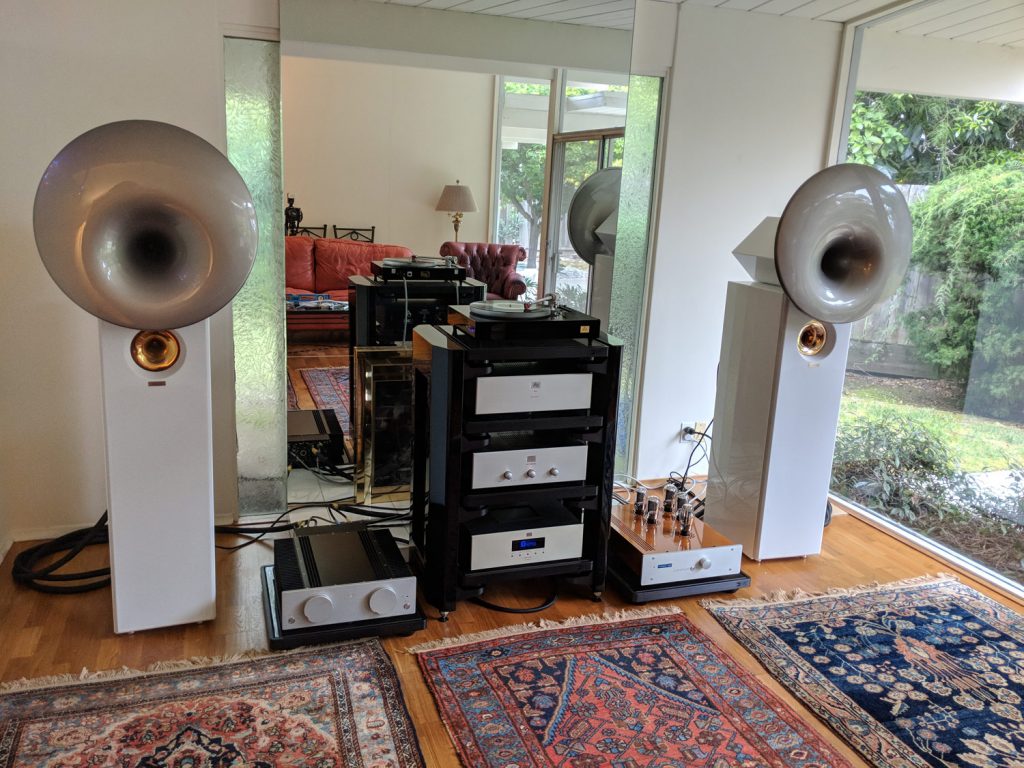
[the initial configuration of the system before the Auralic Aries was added]
THE TOYS
Custom fan-less Roon music server with 8TB disk and small SSD.
Auralic Aries (G1?) streamer
Lampizator Golden Gate 2 – just in from factory update, new PX4 /54UG tubes
Audio Note CDT-Five transport
Audio Note M9 Phono full function preamplifier
Audio Note TT2 Deluxe turntable, AN Arm 3/II, IO One cartridge, S9 step-up transformer
Acapella La Musika integrated amplifier
Acapella Cellini High loudspeaker
Everything on HRS platforms, racks and nimbus couplers
Audio Note SOOTTO and ISIS power cords, Acapella LaMusika (standard) powercord, and Nordost Odin powercords
Audio Note SOOTTO and PALLAS interconnects, Nordost Odin interconnects.
Acapella LaMusika Reference loudspeaker cables
——————————–
All told about $500K in gear
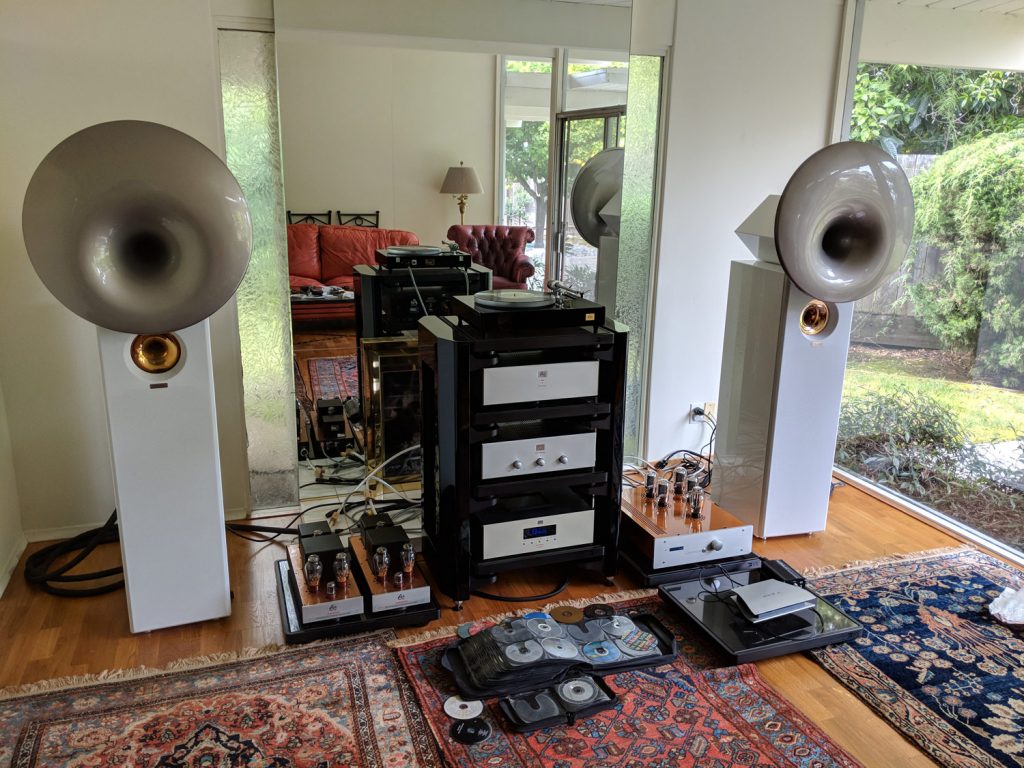
[the final configuration with the Auralic and the Audio Note Kegon amps driving the Acapella Cellini High loudspeakers]
THE SHOOTOUT
The CDT-Five was connected to the Lampizator’s S/PDIF on RCA input, with the Auralic streamer on USB (Tyr 2 USB cable). The Lampizator was then either driving [at Unity Gain, no attenuation] the M9 Phono preamplifer, the La Musika integrated, or, using the Lampizator volume control, the La Musika amp and Kegon amps directly. Kegons are single-ended (RCA) only, everything else (M9Phono, LaMusika) connected using transformer coupled balanced (XLR).
We played a track from each of 3 albums for which we had both the downloaded DSD files on the music server and the CDs [and often LPs, but we did not explore this much] and we went back and forth comparing the quality of the sound and experience between these two sources with respect to many [my guess is between 20 and 30] different configurations of gear and cables and Roon settings.
The three tracks chosen were Holly Cole’s latest ‘Holly’ [track 5], Radiohead’s In Rainbows [track 8], and Alison Krauss and Union Station Live [track 4].
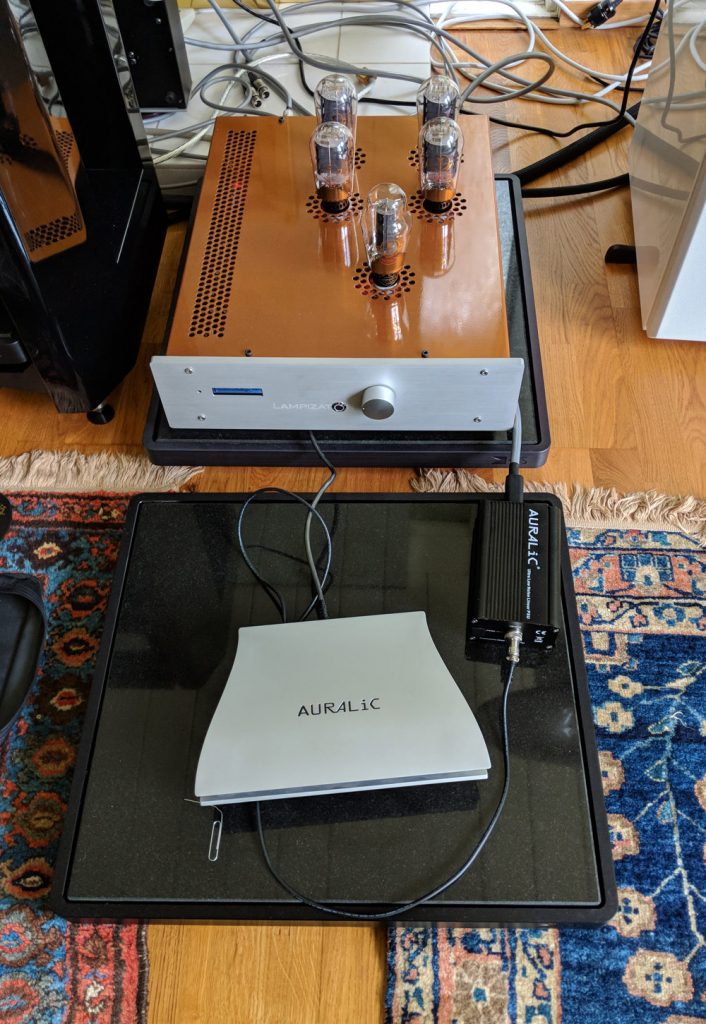
[the Auralic Aries running into the Lampizator Golden Gate both on HRS M3X isolation bases. The paper clip there was used to reset the Auralic each time we changed anything because someone forgot to bring the Auralic’s remote control 🙂 In fact we often had to reset the Auralic twice when we made a change – then things worked just fine]
THE RESULTS
Going from the Audio Note ISIS power cord to the SOOTTO power cord on the power supply for the Auralic streamer made a huge improvement in warmth and harmonic content and musicality of the sound. In this configuration we also happened to have the Odin PC on the Lampizator, which was running at Unity Gain [not using the Lampizator preamp] into the Acapella integrated, which was using an Odin power cord. In my opinion this was the best sounding configuration. Almost entirely Mind but with enough Heart that it worked for me.
To my ears [not sure anyone else heard much of a difference. I mean, why should there even be any difference? but often blind I could tell many times that we had just gone from SSD to Hard Drive], each time we went back and forth between the DSD files on the hard drive vs. the same files on the SSD, the hard drive always sounded better [less harsh and jagged, less noisy, and less weird poop going on that is really hard to describe].
After spending many many hours messing with Roon, we found out how to turn off most (or all) of the Roon processing, and then, by actually turning it off, we made a huge positive difference and my ears were able to finally relax [in fact it was almost a physical sensation – my ears had been freaking out, apparently :-)] and we all agreed: Much Improved. [presumably this meant that the Lampizator was taking over as much of the Digital to Analog conversion as possible (which of course is it’s job). Depending on the architecture of your DAC and how well it handles various digital resolutions and formats, YMMV. For example, when the Roon was downsampling the Lampi could have been upsampling it back up to DSD [not uncommon] before then finally downconverting it again for their final hand-off to their internal linestage, in which case just sending the Lampi the DSD, which is what it wants in the first place, saved two conversions which just has to [and did] make the music sound closer to what it is supposed to sound like]. <Neli here … I am pretty sure that the Golden Gate 2 has separate internal paths for DSD and PCM. These two format families take two distinct approaches to the digital signal. So … from the above, I would say that Lampizator’s PCM decoding sounds superior to upsampling everything to DSD512 (8xDSD) then going from there. The USB PCM & DSD input autodetects and internally routes the signal as appropriate. >
Tidal was the worst sounding source as expected – apparently limited to 24×96 and streaming across the Internet instead from a local drive – muddy and mucked up compared to CD and downloaded DSD files – but it kept getting better as we kept making the rest of the chain better – and it frequently wasn’t so poor that it couldn’t be enjoyed.
The 20 watt Audio Note Kegon amps can drive the Acapella Cellini High to 100db [yes you two, it was that loud on a few of those songs at the end IMO] levels in our 13×18 foot room. There was some slight clipping in the midrange at times, but not nearly as much as one might expect, and it controls the speakers like a mean you know what.
There is an incompatibility between the Lampazator output and the Acapella La Musika direct inputs [i.e. using the Lampizator built-in volume control] and manifested such that the bass was mostly AWOL. No such problem running direct to the Kegons [though we are investigating some soundstaging and other anomalies – all we know is it isn’t the Kegons: it is either humans mucking up or the linestage in the Lampizator mucking up – there is just not much else in the system right now. We’ll learn more over the next week or two].
Neli and J. like to play music very loud [100+ db] – I spent much of the first evening in a different room 🙂 *I* can still hear high frequencies 🙂 The next day they let me stay and kept it under 90+ dB almost the entire day [thanks you two! :-/ ]
We ran wireless, (custom Roon core server connected to its dedicated Cisco Meraki MR18 wireless access point) with only one dropout during the 16+ hours of music [we get about 120M/s bandwidth – good bandwidth is one of the perks being here in The Valley] and line of sight (so to speak) being about 15 feet through a thin wall].
The CD playback through the [albeit rather expensive, very high-quality] redbook-only CDT-Five transport to the Lampizator was consistently more open sounding, more dynamic, slightly warmer and with less resolution. Although the sometimes spectacular resolution of the Streaming music was able to render the subtle intonations of, say, human voice amazingly well, there was still difficulty for us humans making a connection with the music.
The Lampizator has this ‘feature’, in my opinion a bug, where it saves and restores the volume setting not just after being on stand-by, which makes some sense, but after power cycles – we spent almost the entire shootout with the volume at 0 dB – Unity Gain – using the Audio Note M9 Phono or the Acapella La Musika integrated as preamplifiers [attenuators]. But there were a few times Neli had to go thru and reset all the volumes down to -40dB [which is still around 65dB on the Kegons!] when we went from using an outboard preamp with the Lampizator, like the M9 or La Musika, to driving amps directly using the Lampizator volume control.
We spent way too much time in the DSD512 mode on the Lampizator, which was about 3dB down from [quieter than] the CD input before we discovered that the USB PCM & DSD input sounded not only much better but additionally was at the same volume as the CD input [so Neli was then saved from having to jump up and adjust the volume each time we switched from CD to Streaming. I tell her being an audiophile keeps her slim and fit].
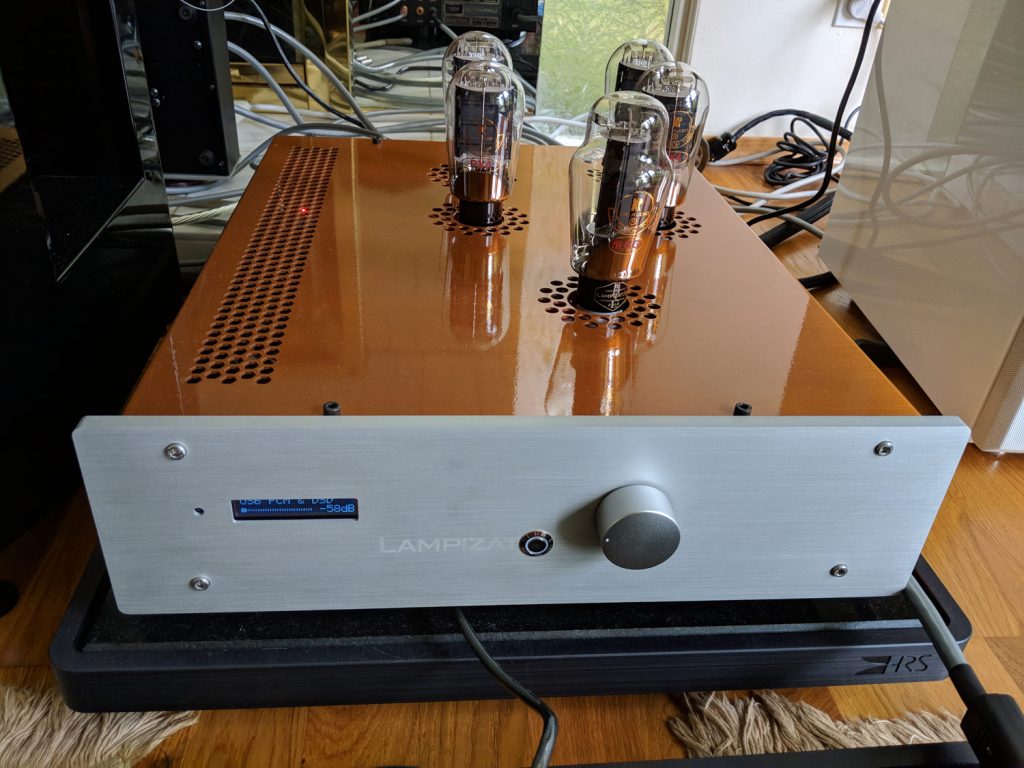


[The Lampizator Golden Gate rear panel]
NEXT STEPS
We will play a lot more with this over the next few weeks before J. takes his toys back.
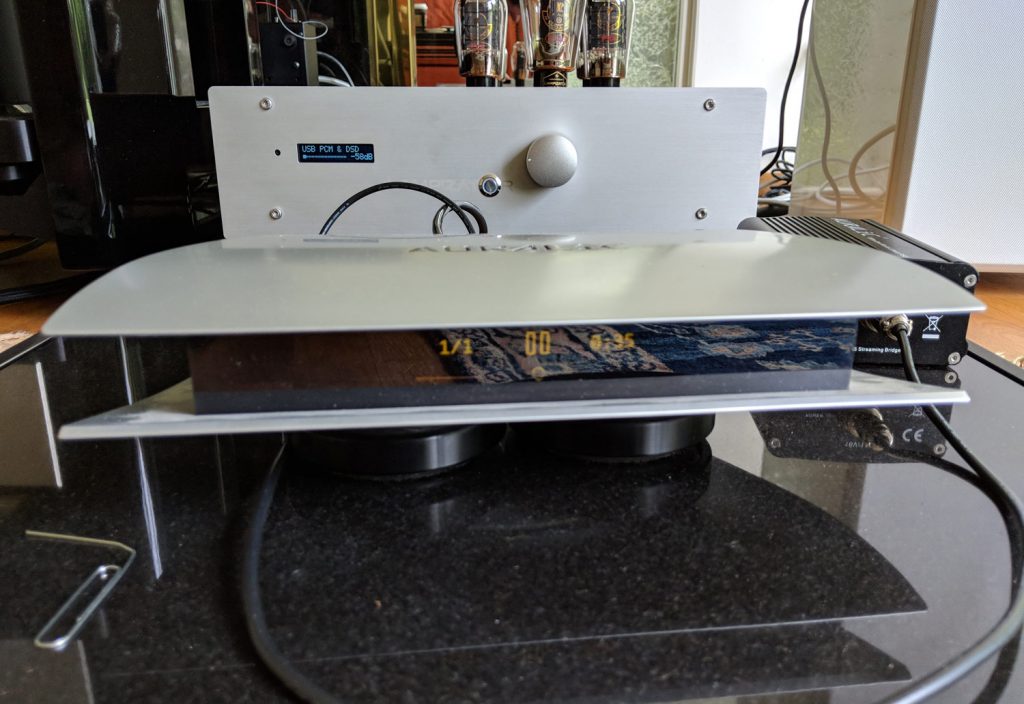
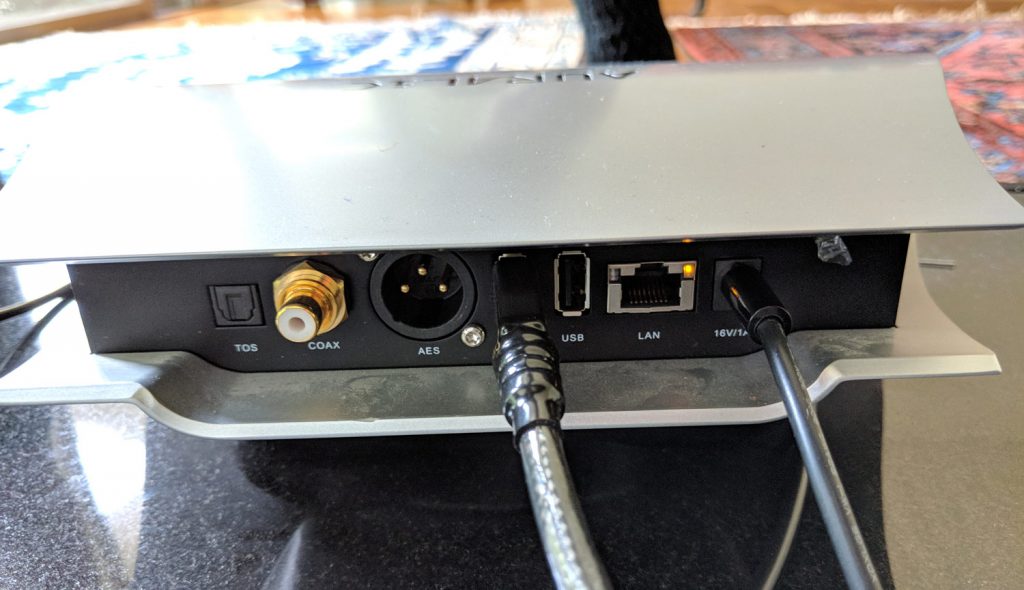
[Auralic Aries G1 rear panel]
OUR TAKEAWAY
When we did finally move the AN SOOTTO PC to the Auralic, it was like night-and-day and we wanted to just hug the female vocalist she [Alison] was so real and her voice so inviting – in this sense there are configurations where the Streaming crosses over from (what can be) very Mind-appealing into being at least somewhat Heart-appealing – and this cross-over is a sound that I want to spend a lot of time in the future indulging in. Looking forward very much to playing with the Emm Labs’ DA2 and also playing with running the Auralic directly into the Audio Note Fifth Element/Fifth Force DAC [using Roon to step things down to 24×96 when needed].
Typically we also really like mixing very high-resolution and tubes – in this case running a very high-res signal into a tube-based preamp and or amp. We want to add the M9 Phono preamp back in the system to take back the volume control duties from the Lampizator and see what that sounds like next.
Should be a blast 🙂


